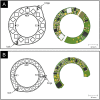A smartphone-enabled wireless and batteryless implantable blood flow sensor for remote monitoring of prosthetic heart valve function
- PMID: 31935231
- PMCID: PMC6959614
- DOI: 10.1371/journal.pone.0227372
A smartphone-enabled wireless and batteryless implantable blood flow sensor for remote monitoring of prosthetic heart valve function
Abstract
Aortic valve disease is one of the leading forms of complications in the cardiovascular system. The failing native aortic valve is routinely surgically replaced with a bioprosthesis. However, insufficient durability of bioprosthetic heart valves often requires reintervention. Valve degradation can be assessed by an analysis of the blood flow characteristics downstream of the valve. This is cost and labor intensive using clinical methodologies and is performed infrequently. The integration of consumer smartphones and implantable blood flow sensors into the data acquisition chain facilitates remote management of patients that is not limited by access to clinical facilities. This article describes the characteristics of an implantable magnetic blood flow sensor which was optimized for small size and low power consumption to allow for batteryless operation. The data is wirelessly transmitted to the patient's smartphone for in-depth processing. Tests using three different experimental setups confirmed that wireless and batteryless blood flow recording using a magnetic flow meter technique is feasible and that the sensor system is capable of monitoring the characteristic flow downstream of the valve.
Conflict of interest statement
The authors have declared that no competing interests exist.
Figures













References
-
- Vilkomerson D, Chilipka T. Implantable doppler system for self-monitoring vascular grafts. IEEE Ultrasonics Symposium. 2005 461–5.

